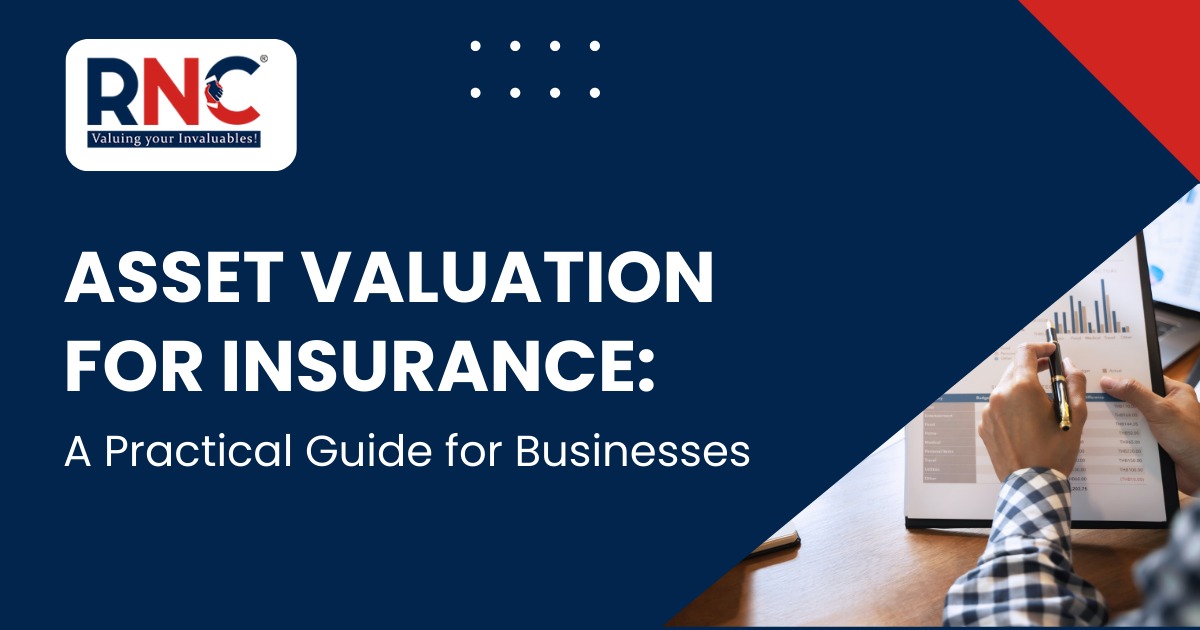
Have you ever wondered if your business assets are insured for their true worth? Many companies discover the gap only during a claim, when underinsurance or outdated values leave them with unexpected financial losses.
Asset valuation—also known as asset appraisal—is the process of determining the accurate value of your business assets for insurance purposes. Without it, insurance coverage can either fall short (underinsurance) or lead to unnecessary higher premiums (overinsurance).
Businesses today face increasing compliance requirements, audit checks, and risk exposures. Accurate insurance valuation not only protects against claim disputes but also ensures financial reporting aligns with regulatory standards.
In this guide, you’ll learn why asset valuation is critical for businesses, the methods used, and how to avoid common pitfalls. We’ll also walk through practical steps to safeguard your organization with the right insurance coverage.
Let’s dive deeper into how businesses can use professional valuation as a tool for security, compliance, and smarter financial decision-making.
Why Accurate Asset Valuation Matters for Businesses
Accurate asset valuation is more than just a financial exercise—it’s a safeguard for your business. When assets are valued correctly, insurance policies reflect their true replacement cost, ensuring that coverage is neither inflated nor insufficient.
From a compliance perspective, valuation directly influences financial reporting. An overstated or understated asset value can distort balance sheets, mislead stakeholders, and trigger regulatory concerns. For businesses subject to audits, proper asset appraisal reduces the risk of discrepancies and strengthens trust with investors, banks, and insurers.
One of the biggest risks businesses face is the insurance coverage gap. Underinsurance often leads to partial claim settlements, while overinsurance results in paying unnecessarily high premiums. Both scenarios harm the financial health of the organization.
Consider this example: A manufacturing company suffered major machinery damage due to flooding. Because the last valuation report was outdated, the insurer settled the claim based on the depreciated indemnity value rather than the actual replacement cost. The business faced a shortfall of several crores, delaying operations and impacting profitability.
In short, accurate insurance valuation protects businesses against unpredictable risks, ensures compliance, and secures smoother claim settlements when it matters most.
Key Assets Businesses Must Value for Insurance
Insurance policies are only as strong as the valuations behind them. For businesses, different categories of assets require careful attention, as each carries unique risks and replacement challenges.
Plant & Machinery Valuation
Industrial plants and heavy machinery represent some of the largest capital investments for businesses. Their replacement cost is often far higher than book value, especially with fluctuating import duties and inflation. Without professional asset appraisal, businesses risk underestimating insurance coverage, leaving themselves exposed during claim settlements.
Real Estate & Infrastructure Valuation
Business infrastructure such as offices, factories, and storage units plays a central role in sustaining operations. A comprehensive insurance valuation considers not just the market value, but also the cost of reconstruction, compliance with new building codes, and inflation adjustments. This ensures businesses can fully recover in case of fire, natural disasters, or other damages.
Inventory & Working Assets
Raw materials, finished goods, and consumables are highly vulnerable to loss or damage. A correct asset valuation for insurance calculates not only current stock but also seasonal variations, ensuring that businesses don’t face an insurance coverage gap during peak production cycles.
By valuing these asset categories correctly, businesses create a robust shield against unforeseen risks while maintaining transparency in financial reporting. Regular professional valuation ensures that coverage limits keep pace with the true economic worth of business assets.
Methods of Asset Valuation for Insurance
Choosing the right method of asset valuation is critical to ensure your insurance coverage truly reflects the value of your business assets. Different methods are applied depending on asset type, business needs, and the insurance company’s requirements.
Reinstatement Value Method
This method calculates how much it would cost to replace an asset with a new one of similar type and capacity. It is the most widely used approach in insurance valuation, as it ensures that businesses can fully recover after a loss without facing shortfalls.
Example: If a machine bought for ₹50 lakhs ten years ago now costs ₹5-7 crores to replace, the insurance coverage should be based on the Reinstatement cost, not the old purchase price.
Market Approach
Here, valuation is determined by comparing similar assets in the open market. While useful for real estate and vehicles, this approach can be tricky for specialized machinery, where market comparables may not exist. It is often used as a cross-check with other methods.
Indemnity Value / Depreciated Replacement Cost
Often applied by insurers, this method deducts depreciation from the replacement cost. While practical, it may result in businesses receiving less than what they need to restore operations, creating an insurance coverage gap if valuations aren’t updated regularly.
By understanding these methods, businesses can make informed decisions and work with valuers to ensure insurance coverage matches real-world risks. At RNC, experts often apply a blended approach, combining methods to deliver the most accurate and defensible valuation.
Asset Valuation for Insurance – A Step-by-Step Framework
For businesses, knowing the theory of asset valuation is important, but what truly matters is how to apply it in practice. A clear, structured framework ensures accuracy, compliance, and peace of mind when claims arise.
Step 1: Identify All Insurable Assets
Begin with a complete inventory of physical and intangible assets.It covers everything from industrial equipment and facilities to office assets, inventories, and in some sectors, intangible resources like IP. Missing assets in the valuation process creates coverage blind spots.
Step 2: Gather Documentation and Historical Data
Collect purchase invoices, maintenance logs, and past valuation reports. Accurate paperwork helps valuers determine the true replacement cost and avoid disputes with insurers.
Step 3: Engage Professional Asset Valuers
Hiring certified professionals ensures credibility and compliance with insurance requirements. A trusted valuer applies the right valuation method—whether replacement cost, market approach, or depreciated value—depending on the asset type.
Step 4: Align Valuation with Insurance Policies
Once the valuation is complete, match the report against your insurance coverage. This prevents underinsurance or inflated premiums, helping businesses strike the right balance between cost and protection.
Step 5: Schedule Regular Reviews and Updates
Asset values change due to inflation, depreciation, and market trends. A yearly review—or sooner in high-risk industries—ensures your insurance valuation always reflects real-world conditions.
“Want to protect your company’s assets through precise insurance coverage assessment? Book an asset valuation consultation with
Talk to our experts today
”
Common Pitfalls in Asset Valuation & How to Avoid Them
- Underinsurance: Outdated reports often leave businesses short during claims — review valuations annually.
- Overinsurance: Paying premiums on inflated values wastes resources — align coverage with actual replacement cost.
- Ignoring Depreciation: Overlooking asset wear-and-tear distorts true value — use updated indemnity value calculations.
- Not Considering Inflation: Rising costs can widen the insurance coverage gap — adjust for market trends.
- Excluding Intangibles: Brands, patents, or goodwill may be overlooked — consult experts for comprehensive coverage.
Case Study – Asset Valuation for Insurance in a Manufacturing Unit
A medium-scale industrial firm experienced severe machinery damage due to a fire outbreak. Their last valuation report was outdated, and the insurer initially considered only the depreciated cost/net book value, which created a huge funding gap for machinery replacement.
When RNC’s valuation team stepped in, a fresh asset appraisal was conducted using the replacement cost method. The updated insurance valuation accurately reflected the real cost of restoring operations, closing the coverage gap and ensuring the claim was settled fairly.
This case highlights how businesses can avoid financial setbacks by partnering with a professional valuation firm like RNC Valuecon LLP, which blends technical expertise with industry experience.
How Often Should Businesses Review Asset Valuation for Insurance?
- Most businesses should update their asset valuation annually to reflect inflation and market changes.
- High-risk industries or rapidly expanding companies may need more frequent reviews, especially after major purchases or mergers.
Conclusion
Accurate asset valuation for insurance is not just about numbers — it’s about protecting your business from unexpected risks, ensuring compliance, and maintaining financial stability. Regular and professional valuations help avoid underinsurance, reduce disputes during claims, and provide confidence to stakeholders.
By keeping asset values updated, businesses can strike the right balance between fair premiums and reliable protection, safeguarding both operations and reputation.
Looking for expert asset valuation services? Get in touch with RNC Valuecon LLP today to protect your enterprise through reliable insurance asset assessments.
FAQs
1. What is asset valuation in insurance?
Asset valuation in insurance determines the accurate worth of business assets to ensure the right coverage and fair claim settlement.
2. What are the standard approaches applied in valuing assets?
The main methods include replacement cost, market approach, income approach, and depreciated indemnity value, depending on asset type and insurance needs.
3. How often should asset valuations be reviewed?
Most businesses should conduct a fresh valuation annually, or sooner after major expansions, acquisitions, or significant economic changes. As a best practice, a detailed valuation should be carried out every 2–3 years to ensure accuracy and compliance.
4. What happens if assets are undervalued in insurance?
Undervaluation leads to underinsurance, where claims may only be partially paid, leaving businesses to cover the shortfall themselves.
5. Can intangible assets be included in insurance valuation?
Yes, in certain industries, intangible assets like intellectual property, goodwill, or brand value can be valued and insured with specialized policies.

About the author:
Sahil Narula
Sahil Narula is the Managing Partner at RNC Valuecon LLP and a Registered Valuer with IBBI. He brings over a decade of experience in Valuation Services, Corporate Finance, and Advisory, having led numerous complex assignments under the Insolvency & Bankruptcy Code, 2016, Mergers & Acquisitions, Insurance, and Financial Reporting.
He is a regular speaker at national forums (ASSOCHAM, CII, ICAI, IBBI, Legal Era) and currently serves as Co-Chairman of ASSOCHAM’s National Council on Insolvency & Valuations and a member of CII’s Task Force on Insolvency & Bankruptcy.
🤝Connect with Sahil on LinkedIn.
